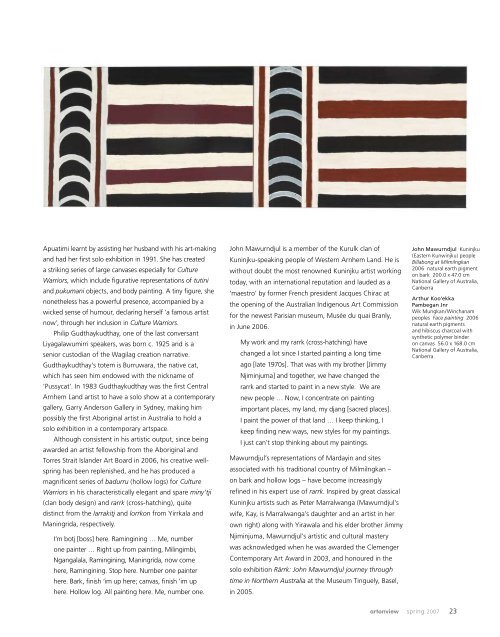Art Ew - National Gallery of Australia
Art Ew - National Gallery of Australia
Art Ew - National Gallery of Australia
You also want an ePaper? Increase the reach of your titles
YUMPU automatically turns print PDFs into web optimized ePapers that Google loves.
Apuatimi learnt by assisting her husband with his art-making<br />
and had her first solo exhibition in 1991. She has created<br />
a striking series <strong>of</strong> large canvases especially for Culture<br />
Warriors, which include figurative representations <strong>of</strong> tutini<br />
and pukumani objects, and body painting. A tiny figure, she<br />
nonetheless has a powerful presence, accompanied by a<br />
wicked sense <strong>of</strong> humour, declaring herself ‘a famous artist<br />
now’, through her inclusion in Culture Warriors.<br />
Philip Gudthaykudthay, one <strong>of</strong> the last conversant<br />
Liyagalawumirri speakers, was born c. 1925 and is a<br />
senior custodian <strong>of</strong> the Wagilag creation narrative.<br />
Gudthaykudthay’s totem is Burruwara, the native cat,<br />
which has seen him endowed with the nickname <strong>of</strong><br />
‘Pussycat’. In 1983 Gudthaykudthay was the first Central<br />
Arnhem Land artist to have a solo show at a contemporary<br />
gallery, Garry Anderson <strong>Gallery</strong> in Sydney, making him<br />
possibly the first Aboriginal artist in <strong>Australia</strong> to hold a<br />
solo exhibition in a contemporary artspace.<br />
Although consistent in his artistic output, since being<br />
awarded an artist fellowship from the Aboriginal and<br />
Torres Strait Islander <strong>Art</strong> Board in 2006, his creative wellspring<br />
has been replenished, and he has produced a<br />
magnificent series <strong>of</strong> badurru (hollow logs) for Culture<br />
Warriors in his characteristically elegant and spare miny’tji<br />
(clan body design) and rarrk (cross-hatching), quite<br />
distinct from the larrakitj and lorrkon from Yirrkala and<br />
Maningrida, respectively.<br />
I’m botj [boss] here. Ramingining … Me, number<br />
one painter … Right up from painting, Milingimbi,<br />
Ngangalala, Ramingining, Maningrida, now come<br />
here, Ramingining. Stop here. Number one painter<br />
here. Bark, finish ‘im up here; canvas, finish ‘im up<br />
here. Hollow log. All painting here. Me, number one.<br />
John Mawurndjul is a member <strong>of</strong> the Kurulk clan <strong>of</strong><br />
Kuninjku-speaking people <strong>of</strong> Western Arnhem Land. He is<br />
without doubt the most renowned Kuninjku artist working<br />
today, with an international reputation and lauded as a<br />
‘maestro’ by former French president Jacques Chirac at<br />
the opening <strong>of</strong> the <strong>Australia</strong>n Indigenous <strong>Art</strong> Commission<br />
for the newest Parisian museum, Musée du quai Branly,<br />
in June 2006.<br />
My work and my rarrk (cross-hatching) have<br />
changed a lot since I started painting a long time<br />
ago [late 1970s]. That was with my brother [Jimmy<br />
Njiminjuma] and together, we have changed the<br />
rarrk and started to paint in a new style. We are<br />
new people … Now, I concentrate on painting<br />
important places, my land, my djang [sacred places].<br />
I paint the power <strong>of</strong> that land … I keep thinking, I<br />
keep finding new ways, new styles for my paintings.<br />
I just can’t stop thinking about my paintings.<br />
Mawurndjul’s representations <strong>of</strong> Mardayin and sites<br />
associated with his traditional country <strong>of</strong> Milmilngkan –<br />
on bark and hollow logs – have become increasingly<br />
refined in his expert use <strong>of</strong> rarrk. Inspired by great classical<br />
Kuninjku artists such as Peter Marralwanga (Mawurndjul’s<br />
wife, Kay, is Marralwanga’s daughter and an artist in her<br />
own right) along with Yirawala and his elder brother Jimmy<br />
Njiminjuma, Mawurndjul’s artistic and cultural mastery<br />
was acknowledged when he was awarded the Clemenger<br />
Contemporary <strong>Art</strong> Award in 2003, and honoured in the<br />
solo exhibition Rärrk: John Mawurndjul journey through<br />
time in Northern <strong>Australia</strong> at the Museum Tinguely, Basel,<br />
in 2005.<br />
John Mawurndjul Kuninjku<br />
(Eastern Kunwinjku) people<br />
Billabong at Milmilngkan<br />
2006 natural earth pigment<br />
on bark 200.0 x 47.0 cm<br />
<strong>National</strong> <strong>Gallery</strong> <strong>of</strong> <strong>Australia</strong>,<br />
Canberra<br />
<strong>Art</strong>hur Koo’ekka<br />
Pambegan Jnr<br />
Wik Mungkan/Winchanam<br />
peoples Face painting 2006<br />
natural earth pigments<br />
and hibiscus charcoal with<br />
synthetic polymer binder<br />
on canvas 56.0 x 168.0 cm<br />
<strong>National</strong> <strong>Gallery</strong> <strong>of</strong> <strong>Australia</strong>,<br />
Canberra<br />
artonview spring 2007 23

















